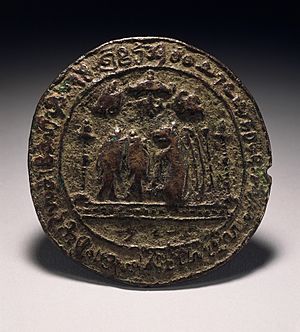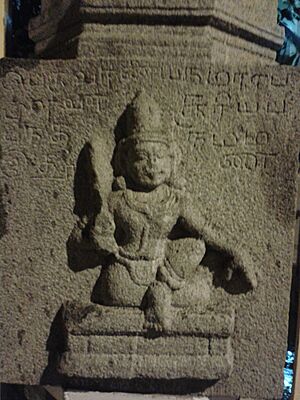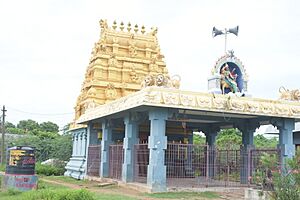Rajendra I facts for kids
Quick facts for kids Rajendra I |
|
|---|---|
| Parakesari Varman, Yuddhamalla, Mummudi Cholan,Gangai Kondan, Kadaram Kondan, Jayasimha Kula Kaalan, Chalukya Chudaamani, Thelagaramari (Thelungu Kula Kaalan), Rattapadi Konda Chola | |

Sculpture of Rajendra I represented as Lord Chandikeswara (Gangaikonda Cholapuram)
|
|
| Chola Emperor | |
| Reign | 1014 CE – 1044 CE |
| Predecessor | Rajaraja I |
| Successor | Rajadhiraja I |
| Co-Regent of the Chola Empire | |
| Reign | 1012 CE – 1014 CE |
| Emperor | Rajaraja I |
| Successor | Rajadhiraja I |
| King of Dakkinadesa King of Ruhuna |
|
| Reign | 1017 CE – 1044 CE |
| Predecessor | Kassapa VI |
| Successor | Rajadhiraja I |
| Born | Madhurantaka Chola 26 July 971 Thanjavur, Chola Empire (modern day Tamil Nadu, India) |
| Died | 1044 CE (aged 73) Brahmadesam, Chola Empire (modern day Tiruvannamalai, Tamil Nadu, India) |
| Burial | End of 1044 CE Brahmadesam, Tamil Nadu, India |
| Spouse |
|
| Issue |
|
| Dynasty | Chola |
| Military career | |
| Service | Chola Army Chola Navy |
| Years of service | 992 – 1044 CE |
| Rank | Senathipathi (992 – 1014 CE) Chakravarti (1014 – 1044 CE) |
| Father | Rajaraja I |
| Mother | Vanavan Mahadevi alias Tribhuvana Mahadevi |
| Religion | Hinduism |
| Signature | |
Rajendra I (born 26 July 971 CE – died 1044 CE) was a powerful Chola Emperor. People often called him Rajendra the Great. He was also known as Gangaikonda Cholan, meaning "Bringer of the Ganges River". Another title was Kadaram Kondan, which means "Conqueror of Kedah".
Rajendra ruled the Chola Empire from 1014 to 1044 CE. He was born in Thanjavur to Rajaraja I and Queen Vanavan Mahadevi. He became a co-ruler with his father in 1012. When his father died in 1014, Rajendra became the full emperor. During his time, the Chola Empire became very strong in the Indian subcontinent. It also grew through trade and conquests across the Indian Ocean. This made Rajendra one of the few Indian rulers to conquer lands outside South Asia.
In his younger years, Rajendra was part of the Chola Army. He fought in many battles against the Western Chalukyas and the rulers of Anuradhapura. These battles gave him his first victories. He also stopped rebellions in the Chera and Pandiya kingdoms, and in Sri Lanka. As Emperor, Rajendra finished conquering Anuradhapura. He brought a large part of Sri Lanka under Chola rule.
Rajendra made the Chola Empire even bigger. He defeated the kingdoms of Kalinga and Vengai. He also took over the islands of Laccadives and the Maldives. He renamed these islands "Twelve Thousand Islands and the Ocean Where Three Waters Meet". These islands were important naval bases. During his campaign in Southeast Asia, he took over Srivijaya, Kedah, Tambralinga, and Pegu. This made the Chola Empire very powerful in that region. It also helped to spread Indian culture in Southeast Asia.
Rajendra fought a war against the Pala dynasty. He captured a lot of treasure from them. He used this wealth to build the city of Gangaikondacholapuram. This city became the new capital of the Chola Empire. It was a major center for trade for many centuries. The city was famous for its artificial lake, strong walls, and moats around the palace. It also had the beautiful Brihadisvara Temple. Rajendra followed Shaivism (a branch of Hinduism). However, he also welcomed Buddhism and built many stupas (Buddhist shrines) in South-East Asia and South India.
New ways of trading appeared during Rajendra's rule. One was called "emporia". This happened after the Cholas controlled the Strait of Malacca and other coastal areas. Emporia meant exporting goods based on what people wanted. This made trade profitable and helped support the Chola army. The Khmer Empire was a big friend and trading partner. They helped the Cholas trade with places as far as Song China. This connection even allowed Rajendra to use Chinese ships in his navy. The Chola trade networks also went west. They traded spices with Arabia, North Africa, Anatolia, and Turkic peoples.
Rajendra Chola I was followed by his son Rajadhiraja I. Rajadhiraja ruled from 1044 to 1054 CE.
Contents
Early Life and Becoming Emperor
Rajendra I was likely born around 971 CE. He was the son of Rajaraja I and Queen Vanathi. She was also known as Thiripuvāna Mādēviyār. Rajendra had a younger brother and at least three sisters.
In the last years of his father's rule (1012–1014), Rajendra became the heir to the throne. He helped his father manage the Chola Empire. In 1018, Rajendra made his own son, Rajadhiraja, the heir. Rajadhiraja then ruled with his father from 1018 to 1044.
Great Military Victories
Rajendra started his wars on the Indian mainland in 1012. He was still co-ruler with his father. He captured areas like Aduthurai in Tamil Nadu and Vanavasi. In 1013, he took Kollipaakkai in Andhra Pradesh. In 1014, Rajendra fought against Irratiapaadi ElaraIiakam in Karnataka and Maharashtra. He captured its capital, Mannaikadakkam.
After his father's death in 1014, Rajendra became emperor. In 1016, he sent a navy to Sri Lanka. He brought the Anuradhapura Kingdom under his control. In 1017, he captured Kudamalai Nadu in eastern Kerala.
In 1018, Rajendra's forces took the Maldives and Lakshadweep islands. In 1019, he sent another army against Irrataipaadi Elaraiillakam. They recaptured Kalyani after a battle. Rajendra then wanted to conquer northern India. In 1021, he captured Sakkarakkoattam in southern Chhattisgarh. He sent parts of his army to the Ganges river and to the northwest.
His army reached the Ganges river in 1022. They conquered regions like Odda Vishayam in Odisha and Kosala Naadu in northern Chhattisgarh. They also took Thakkana Laadam and Uttara Laadam in Jharkhand. Finally, they reached Vangala Desam in modern-day Bangladesh. After this victory, Rajendra took the new title "Gangaikondaan". He also gave the title "Gangaikonda Cholan" to his younger brother.
To celebrate, Rajendra started building a new city called "Gangaikonda Cholapuram". He also built a new Siva temple there called "Gangaikonda Cholaeswarem". A large water tank called "Chola Gangam" was also built. Holy water from the Ganges river was mixed into this tank. The temple has a huge Siva Lingam, which is 13 feet tall and 20 feet around.
The Vijayamkonda Cholaeswarem Siva temple in Erumbur was built to remember Rajendra's victory over Sri Vijaya. The Kadaremkonda Cholaeswarem Siva temple in Kudimallur was built to remember his victory over Kadarem.

Rajendra's overseas war started in 1023. A large fleet of Chola ships went to Sri Vijaya. They captured Palembang in southern Sumatra. Then they took Malaiyur, Bangha, Pannai, and Ilamuridesam. The fleet then sailed to Malaysia. They captured Vallaipandur and Kadarem. From there, Rajendra's forces sailed north. They captured Ilankasokam, Mathamalingam, and Thalaitakkolam in Thailand. On their way back to India, they captured Manakkavaarem in the Andaman and Nicobar Islands and Magpapaalam in southern Myanmar. The Southeast Asian campaign ended in 1024.
After his victory over Kadaram, Rajendra took the new title "Kadaremkondaan". One of his grandsons, who led the Kadaram expedition, was called "Kadaremkonda Cholan". Some villages in Tamil Nadu still have names like Kidarankondan.
Rajendra built two huge temples made of granite stone. These temples are now part of the UNESCO World Heritage Series. They celebrate his victories overseas.
Conquest of Sri Lanka
Rajendra's father, Rajaraja I, had already taken over northern Sri Lanka. Rajendra continued this conquest. In 1017, he invaded the Kingdom of Polonnaruwa in the south. By his fifth year as emperor, Rajendra claimed to have fully conquered the island. The whole of Anuradhapura, including the Rohana province, became part of the Chola Empire.
The Sinhalese chronicle Mahavamsa says the conquest of Anuradhapura was finished around 1017–1018. Rajendra captured the Sinhalese king Mahinda V, his queen, and his daughter. He took them as prisoners to India. Mahinda V died in exile in 1029.
However, the Cholas never fully controlled the very south of the island. Prince Kassapa, Mahinda's son, hid in Rohana. After his father's death, Kassapa became King Kassapa VI in Rohana (1029–1040). He tried to free the island from Chola rule. Later, Vijayabahu I of Polonnaruwa (1055–1110) finally defeated the Cholas. He drove them out of Sri Lanka and brought back the island's independence.
Conquest of the Ganges River Region
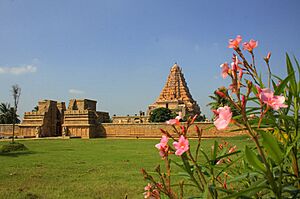
In 1019 CE, Rajendra's army marched through Kalinga towards the Ganges river. In Kalinga, they defeated Indraratha, a ruler from the Somavamsi dynasty. Rajendra worked with the Paramaras and Kalachuris, who were enemies of Indraratha. Their combined armies defeated Indraratha.
The Chola army eventually reached the Pala kingdom of Bengal. There, they defeated Mahipala. They also defeated Dharmapala, the last ruler of the Kamboja Pala dynasty. The Chola army then raided eastern Bengal (modern-day Bangladesh). They defeated Govindachandra and invaded the Bastar region.
To celebrate his victory in the Ganges region, Rajendra built a new capital city. This city was named Gangaikondacholapuram. He also built the Gangaikonda Choleeswarar Temple there. This temple is similar to the Brihadeeswarar Temple in Thanjavur. The name Gangaikonda Cholapuram means "The City of the Conqueror of Ganga River".
Historians believe this campaign was a military one, not just a pilgrimage. The Chola expedition to the Ganges had a lasting impact. Some historians think a chief who went with Rajendra's army settled in Bengal. He might have founded the Sena Dynasty. Many Shaivite Brahmins from Bengal were brought to the Chola country. Rajendra gave them land. They settled in Kanchipuram and the Cauvery Delta.
Campaigns in Southeast Asia
Srivijaya was a kingdom in Palembang, Sumatra. It was ruled by the Sailendra dynasty. At first, Srivijaya and the Chola Empire had good relations. However, the Khmer Emperor Suryavarman I started a war against the kingdom of Tambralinga. He asked Rajendra for help. Tambralinga then asked Srivijaya for help, which was granted. This led to the Chola invasion of the Srivijaya Empire. The Cholas and Khmer Empire were Hindu Shaivites. Tambralinga and Srivijaya were Mahayana Buddhists.
The Cholas benefited from both trade and sometimes from piracy. Chola naval trips sometimes led to taking treasure and conquering lands in Southeast Asia. Srivijaya controlled two important sea routes: the Malacca and Sunda Straits. The Cholas wanted to control these routes.
In 1025 CE, Rajendra's Chola forces crossed the Indian Ocean. They invaded Srivijaya. They attacked many places in modern-day Malaysia and Indonesia. The Cholas captured the capital Kadaram and Pannai on Sumatra. They also took Malaiyur on the Malay Peninsula. Rajendra also invaded Tambralinga and the Gangga Nagara Kingdom. These are in modern-day Malaysia and southern Thailand. Chola forces captured the last ruler of the Sailendra Dynasty, Sangrama Vijayatunggavarman.
The Chola invasion marked the end of Srivijaya's power at sea. Chola forces took over large parts of Srivijaya. This included its ports like Ligor, Kedah, and Tumasik (now Singapore). The Chola invasion helped Tamil merchant groups grow in Southeast Asia. For the next century, Tamil trading companies from southern India were very important in the region.
Even though there was destruction, the Srivijaya kingdom survived. The Chola attack was short and mainly for treasure. It did not lead to direct Chola rule. This invasion weakened Srivijaya's power. It allowed other kingdoms like Kahuripan and Kediri in Java to form. These new kingdoms focused more on farming than on sea trade.
After the invasion, relations between Srivijaya and the Cholas got better. Chola nobles were welcomed in the Srivijaya court. In 1067, a Chola prince named Divakara was sent as an ambassador to China. This prince, who was Rajendra Chola's nephew, became Emperor Kulothunga Chola I in 1070.
Death

Rajendra I died in 1044 in Brahmadesam. This is in modern-day Tiruvannamalai district, Tamil Nadu. An inscription says that Rajendra's queen, Viramahadevi, performed sati when her husband died. This means she chose to die on his funeral pyre. Her remains were buried in the same tomb in Brahmadesam. The queen's brother, Madhuranthaka Parakesari Velan, built a water tank there to remember his sister.
Personal Life and Family
Rajendra Chola I was also a poet. He wrote hymns to praise the god Siva. Some writings say Rajendra brought many Shaivite priests from the Ganges river area. He settled them in Kanchi and other parts of the Chola Empire.
Titles
After his successful campaign to the Ganges river in North India, Rajendra earned the title Gangaikonda Chola. This means "The Chola who took the Ganges river". After his successful Southeast Asian campaign, he gained the title "Kadaram Kondan". This means "He who took Kedah".
He also inherited the title Mummudi Cholan from his father. This means "Chola with three crowns". It was used by Tamil kings who ruled the three kingdoms of Cholas, Pandyas, and Cheras. Rajendra took other titles to celebrate his victories, like Mudigonda Cholan.
Family
Rajendra I had several queens. These included Tribhuvana, Mukkokilan, Panchavan Mahadevi, Puteri Onangki, and Viramahadevi. Viramahadevi performed sati after Rajendra's death. He had seven sons and two known daughters. His son Rajadhiraja became emperor after him.
What Rajendra Built and Left Behind
Temples and Cities
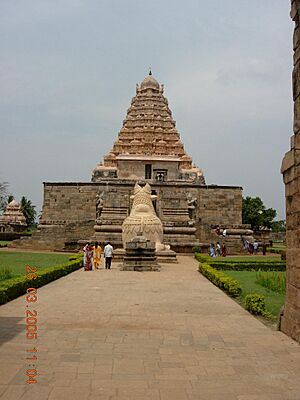
Rajendra Chola I built many important places. He built Gangaikondacholapuram to celebrate his victory over the Pala Dynasty. This city became his capital for the next 250 years. The city has an artificial lake. It also had strong outer walls and a palace. Most of the other temples he built were destroyed later. Only the Brihadishvara temple remains.
Rajendra also built a royal palace from burnt brick. The ceilings were covered with flat tiles. The pillars were likely made of polished wood. A tunnel connected the palace to the temple.
Rajendra also improved the Koneswaram temple in Trincomalee, Sri Lanka. He also expanded the Pathirakali Amman Temple in Trincomalee. Many pilgrims visited this temple during his rule.
Rajendra created a good water management system. It worked from the village level up. He built a large tank called Cholagangam in his capital city. It was called the "liquid pillar of victory".
Inscriptions
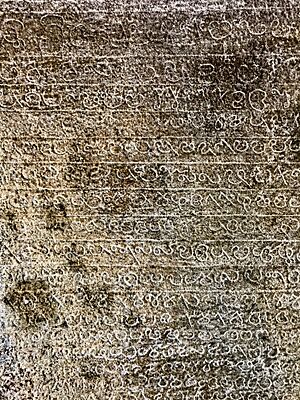
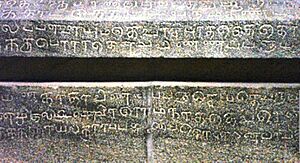
Many inscriptions from Rajendra's reign have been found. They tell us about his rule and his conquests. An inscription at Adhipuriswara temple tells us his birth star was Tiruvadarai. Donations were made to the temple to celebrate his birthday. Inscriptions at the Rajarajeswaramudaiya Mahadevar Temple also describe donations made by Rajendra.
Images for kids
-
Sculptures of Shiva and Parvati at Gangaikonda Cholapuram
See also
- Chola Empire
- Chola Navy
- List of Indian monarchs
- History of south India
- List of Tamil monarchs



